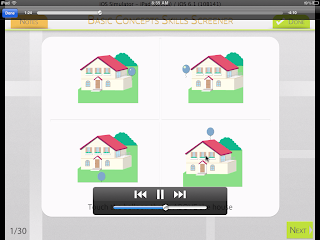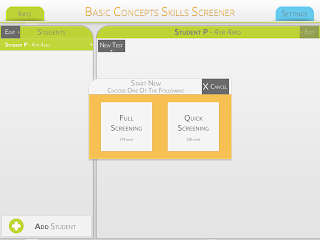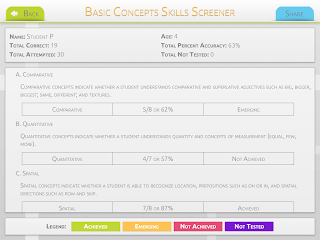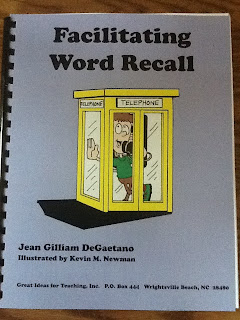I recently reviewed a fun game by PlaSmart Inc., called Morphology, where participants choose a card and then "animate" the card using various objects, gestures, and/or noises.
This game can be used to demonstrate the importance of gestures. It can also be used to teach problem solving, as well as abstract ways to represent an item.
The game comes with easier and harder playing cards, as well as a game board, frog playing pieces, as well as a variety of items to build the items on the cards, including beads, blocks, string, etc.
A roll of the die determines how the player will describe the word on his/her card.
Above is an example of using yellow and black blocks to describe the word "bee".
You can find this neat game from PlaSmart Inc. for $29.99 HERE!
Disclaimer: This product was given to me for review. No other compensation was provided. The opinions expressed here are solely my own.
Saturday, August 31, 2013
Friday, August 30, 2013
SLPs Hopping Back to School!
Time to head back to school! I hope you are all as excited as I am to get back into the swing of things! That being said, a bunch of bloggers got together to create awesome back to school materials to make the start of the school year a little easier. (Oh, and we're also giving away some great prizes as well!) To be eligible to win one of the prizes, collect all of the letters from the various blogs to create a few words. Here's a look at some of the awesome prizes!
I love working on silly sentences with students. Not only does it provide a bit of humor, it can be used to target a variety of skills, (and provide a little bit of baseline data as far as a student's skills are concerned!) You can grab "Crazy Back to School Sentences" for FREE HERE!
Also, here's my letter... Make sure to grab it along with all the other letters that you'll find along the "hop route".
Ready to do some more hopping? Great! Have fun!!!
I love working on silly sentences with students. Not only does it provide a bit of humor, it can be used to target a variety of skills, (and provide a little bit of baseline data as far as a student's skills are concerned!) You can grab "Crazy Back to School Sentences" for FREE HERE!
Also, here's my letter... Make sure to grab it along with all the other letters that you'll find along the "hop route".
Ready to do some more hopping? Great! Have fun!!!
A special thank you to all of our great "sponsors"!
Thursday, August 15, 2013
{Review} Thinking About You, Thinking About Me
Social language is one of my favorite areas to target, and I love gaining more knowledge in this area. Thinking About You, Thinking About Me by Michelle Garcia Winner certainly delivers in the information department with a wealth of new and interesting ways to look at this topic.
This book is a great place to start in your understanding of perspective taking and social thinking, whether you're new to working on social interaction and social awareness, or whether you need a refresher in the area. Understanding that people have perspectives other than their own is a difficult skill for students with high-functioning autism, Asperger syndrome, and ADHD to master.
Since this book has SO much information, I've decided to highlight some of my favorite aspects of this fantastic resource.
One of the sections of the book that I found particularly interesting was the spectrum of perspective taking deficits. Three different levels are described here including:
- Severely Impaired Perspective Taker
- Emerging Perspective Taker
- Impaired Interactive Perspective Taker
Each level includes 11-18 symptoms, a prognosis for the perspective taker, as well as effective teaching strategies when working with the student. I found that as I read the symptoms of each perspective taker, I found myself recalling specific students on my caseload and thinking of how well each of them fit the various descriptions and levels. I also feel that I have a much better understanding of how to work with my students who have impairments in perspective taking, and that I also have new strategies to suggest to teachers for each one of them.
Included in chapter two is an extended discussion of "thinking about how others affect you" and "others thinking about you". This section presents additional information in each of these areas, as well as logical deficits that would be present if a child lacked these skills.
Next, is a section about the four steps to communication, including:
1) Thinking about people: anchoring your thoughts on your communicative partner(s).
2) Being ware of your physical presence as well as the physical presence of your communicative partner(s).
3) Using your eyes to think about others and watch what they are thinking about.
4) Using your language to relate to others.
I love the figures, tables, and handouts that make teaching these concepts to students at a variety of levels really easy. The figures include child friendly language and can easily be integrated into therapy sessions.
One of my favorite concepts by Michelle Garcia Winner is the idea of "expected vs. unexpected behaviors". The pages below include a chart for both expected and unexpected behaviors, as well as how they make others feel, consequences you experience, and how you feel about yourself. This guide is one that I feel I will be using often this year to discuss behaviors in the classroom, hall, lunchroom, outside at recess, at what our district calls "specials" - art, gym, music, at home, etc.
You can find out more about social thinking HERE. (I really suggest that you do if you have a few minutes. Personally, I find it so logical and easy to understand.)
You can find this extremely informative and useful resource for social interaction and social awareness for $48 HERE.
Disclaimer: This product was given to me for review. No other compensation was provided. The opinions expressed here are solely my own.
This book is a great place to start in your understanding of perspective taking and social thinking, whether you're new to working on social interaction and social awareness, or whether you need a refresher in the area. Understanding that people have perspectives other than their own is a difficult skill for students with high-functioning autism, Asperger syndrome, and ADHD to master.
Since this book has SO much information, I've decided to highlight some of my favorite aspects of this fantastic resource.
One of the sections of the book that I found particularly interesting was the spectrum of perspective taking deficits. Three different levels are described here including:
- Severely Impaired Perspective Taker
- Emerging Perspective Taker
- Impaired Interactive Perspective Taker
Each level includes 11-18 symptoms, a prognosis for the perspective taker, as well as effective teaching strategies when working with the student. I found that as I read the symptoms of each perspective taker, I found myself recalling specific students on my caseload and thinking of how well each of them fit the various descriptions and levels. I also feel that I have a much better understanding of how to work with my students who have impairments in perspective taking, and that I also have new strategies to suggest to teachers for each one of them.
Included in chapter two is an extended discussion of "thinking about how others affect you" and "others thinking about you". This section presents additional information in each of these areas, as well as logical deficits that would be present if a child lacked these skills.
Next, is a section about the four steps to communication, including:
1) Thinking about people: anchoring your thoughts on your communicative partner(s).
2) Being ware of your physical presence as well as the physical presence of your communicative partner(s).
3) Using your eyes to think about others and watch what they are thinking about.
4) Using your language to relate to others.
I love the figures, tables, and handouts that make teaching these concepts to students at a variety of levels really easy. The figures include child friendly language and can easily be integrated into therapy sessions.
One of my favorite concepts by Michelle Garcia Winner is the idea of "expected vs. unexpected behaviors". The pages below include a chart for both expected and unexpected behaviors, as well as how they make others feel, consequences you experience, and how you feel about yourself. This guide is one that I feel I will be using often this year to discuss behaviors in the classroom, hall, lunchroom, outside at recess, at what our district calls "specials" - art, gym, music, at home, etc.
You can find out more about social thinking HERE. (I really suggest that you do if you have a few minutes. Personally, I find it so logical and easy to understand.)
You can find this extremely informative and useful resource for social interaction and social awareness for $48 HERE.
Disclaimer: This product was given to me for review. No other compensation was provided. The opinions expressed here are solely my own.
Wednesday, August 14, 2013
{Review} Basic Concepts Skills Screener
With the beginning of the school year right around the corner, I know that I'll need to get a good understanding of where each of my student's skills lie and Smarty Ears's Basic Concepts Skills Screener is a great way to get started!
and adding their birth date.
The app includes both a full screening that has 79 items, as well as a quick screening that includes 30 items.
Here is an example of one of the questions. The app reads the question to the participant and records correct vs. incorrect answers.
The app also keeps track of when the assessments were given, as well as the raw score and type of test, which is great for showing progress over time.
My favorite part of the app is the detailed information that the app provides in regard to a student's strengths and areas for growth. The assessment starts with a brief overview of the skills that the app tests.
Also included is a break down between correct vs. incorrect responses/concepts.
In addition, there is a breakdown of the concept type (e.g. comparative, quantitative, spatial, etc).
Last, but not least, is a breakdown by age.
What I love about this app:
- It is very easy to use!
- It provides an extremely detailed explanation of the child's understanding of basic concepts, and breaks the information down in various ways.
- The pictures provided in the screening are detailed and self-explanatory.
You can find this awesome basic concept screener for $19.99 at iTunes! (Currently on sale for $9.99!)
Disclaimer: This product was given to me for review. No other compensation was provided. The opinions expressed here are solely my own.
This app is a wonderful screening tool to acquire detailed information of a student's understanding of basic concepts.
The tutorial offers information on how to use the app as well as how to interpret the results.
It's easy to get started by adding a new student's name,
and adding their birth date.
The app includes both a full screening that has 79 items, as well as a quick screening that includes 30 items.
Here is an example of one of the questions. The app reads the question to the participant and records correct vs. incorrect answers.
The app also keeps track of when the assessments were given, as well as the raw score and type of test, which is great for showing progress over time.
My favorite part of the app is the detailed information that the app provides in regard to a student's strengths and areas for growth. The assessment starts with a brief overview of the skills that the app tests.
Also included is a break down between correct vs. incorrect responses/concepts.
In addition, there is a breakdown of the concept type (e.g. comparative, quantitative, spatial, etc).
Last, but not least, is a breakdown by age.
What I love about this app:
- It is very easy to use!
- It provides an extremely detailed explanation of the child's understanding of basic concepts, and breaks the information down in various ways.
- The pictures provided in the screening are detailed and self-explanatory.
You can find this awesome basic concept screener for $19.99 at iTunes! (Currently on sale for $9.99!)
Disclaimer: This product was given to me for review. No other compensation was provided. The opinions expressed here are solely my own.
Tuesday, August 13, 2013
{Review} School of Multi-Step Directions
I can never have too many resources that target direction following. I'll be the first to admit that I am absolutely horrible with coming up with multi-step directions on the spot. That's why I'm thrilled to add Virtual Speech Center's newest app, School of Multi-Step Directions, to my arsenal!
As with any app, the tutorial is the best way to get a quick understanding of what the app has to offer and how to use it.
Now, it's time for a little bit of set up. These settings make the app a bit more customized to your needs.
Now, you'll need to add the players, which is really easy. Simply click "add student" and type in the name of each player.
You'll notice on the left side of the screen that you can choose to follow directions related to English, math, or chemistry.
The English directions offer two-step, three-step, and four-step directions at various levels.
Here, the app asked the player to highlight the cat and underline the umbrella.
The math directions offer two-step, three-step, and four-step directions at various levels as well.
Here, the app asked the player to highlight the triangle, cross out the square, and underline the circle.
The chemistry directions offer two-step, three-step, and four-step directions at various levels.
Here, the app asked the student to shake the first blue flask and stir the last yellow flask.
You can also get results for each of your student as well.
What I love about this app:
- Students must wait until the direction has completed until starting to follow it.
- I love how the app incorporates different "subjects" and has various levels in each subject.
- I like that this app collects data for you.
You can find this awesome multi-step direction following app for $16.99 at iTunes!
Disclaimer: This product was given to me for review. No other compensation was provided. The opinions expressed here are solely my own.
As with any app, the tutorial is the best way to get a quick understanding of what the app has to offer and how to use it.
Now, it's time for a little bit of set up. These settings make the app a bit more customized to your needs.
Now, you'll need to add the players, which is really easy. Simply click "add student" and type in the name of each player.
You'll notice on the left side of the screen that you can choose to follow directions related to English, math, or chemistry.
The English directions offer two-step, three-step, and four-step directions at various levels.
Here, the app asked the player to highlight the cat and underline the umbrella.
The math directions offer two-step, three-step, and four-step directions at various levels as well.
Here, the app asked the player to highlight the triangle, cross out the square, and underline the circle.
The chemistry directions offer two-step, three-step, and four-step directions at various levels.
Here, the app asked the student to shake the first blue flask and stir the last yellow flask.
You can also get results for each of your student as well.
What I love about this app:
- Students must wait until the direction has completed until starting to follow it.
- I love how the app incorporates different "subjects" and has various levels in each subject.
- I like that this app collects data for you.
You can find this awesome multi-step direction following app for $16.99 at iTunes!
Disclaimer: This product was given to me for review. No other compensation was provided. The opinions expressed here are solely my own.
Friday, August 2, 2013
{Review} Facilitating Word Recall
I recently wrote a blog post about strategies to improve word finding, because I have many students (and adults - as I work in subacute rehab facilities) that are working on this goal area. Great Ideas for Teaching also has a fantastic resource to target this skill, called "Facilitating Word Recall".
This book includes 100 reproducible pages that target word recall in a variety of activities.
Here is my favorite activity in the book. Each 2-page unit includes a picture page with four different pictures.
On the instructor's worksheet, there are 6 questions for each picture that target frequently used words associated with the picture.
Another option in this book is a fill-in-the-blank with picture cues choice.
Some of the prompts include:
- "I put ketchup on my ___________."
- "Mother wore a strand of ___________."
- "The blades whirled on the ____________."
- "The whole was made with a ____________."
Students must look through the pictures and name the picture on the page that appropriately fills in the blank.
Still another option in this book is a fill-in-the-blank with picture prompts. The pictures do not indicate the answer to the question, but help a student determine the correct response to the question.
Some of the prompts include:
- "A boy lives in a ___________."
- "Monkeys live in a ___________."
- "Cows and horses live on a ___________."
- "Birds fly in the ____________."
- "Whales live in the ____________."
The last option in this book includes labeling objects seen in a picture with prompts as necessary. (The pictures invite a lot of language and further discussion than just naming objects.)
What I love about this book:
- It includes many different ways to target a student's ability to recall words. Variety is the spice of life, after all!
- Because the instructor's worksheet is so self explanatory, the activities can easily be sent home with students as homework.
You can find this fantastic word recall resource for $29.50 HERE!
Disclaimer: This product was given to me for review. No other compensation was provided. The opinions expressed here are solely my own.
This book includes 100 reproducible pages that target word recall in a variety of activities.
Here is my favorite activity in the book. Each 2-page unit includes a picture page with four different pictures.
On the instructor's worksheet, there are 6 questions for each picture that target frequently used words associated with the picture.
Another option in this book is a fill-in-the-blank with picture cues choice.
Some of the prompts include:
- "I put ketchup on my ___________."
- "Mother wore a strand of ___________."
- "The blades whirled on the ____________."
- "The whole was made with a ____________."
Students must look through the pictures and name the picture on the page that appropriately fills in the blank.
Still another option in this book is a fill-in-the-blank with picture prompts. The pictures do not indicate the answer to the question, but help a student determine the correct response to the question.
Some of the prompts include:
- "A boy lives in a ___________."
- "Monkeys live in a ___________."
- "Cows and horses live on a ___________."
- "Birds fly in the ____________."
- "Whales live in the ____________."
The last option in this book includes labeling objects seen in a picture with prompts as necessary. (The pictures invite a lot of language and further discussion than just naming objects.)
What I love about this book:
- It includes many different ways to target a student's ability to recall words. Variety is the spice of life, after all!
- Because the instructor's worksheet is so self explanatory, the activities can easily be sent home with students as homework.
You can find this fantastic word recall resource for $29.50 HERE!
Disclaimer: This product was given to me for review. No other compensation was provided. The opinions expressed here are solely my own.
Subscribe to:
Posts (Atom)

.JPG)
.JPG)
.JPG)
.JPG)








.JPG)
.JPG)
.JPG)

.JPG)
.JPG)



























.JPG)
.JPG)
.JPG)
.JPG)
.JPG)